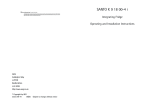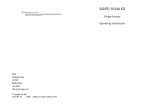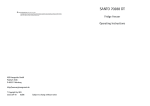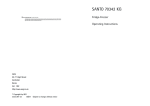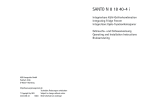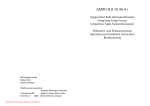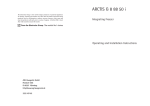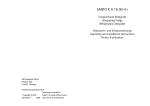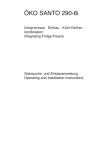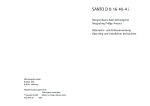Download Electrolux 75428-1 DT User manual
Transcript
SANTO 75428-1 DT User Manual Fridge Freezer Dear Customer Thank you for choosing one of our high-quality products. With this appliance you will experience the perfect combination of functional design and cutting edge technology. Convince yourself that our appliances are engineered to deliver the best performance and control - indeed we are setting the highest standards of excellence. In addition to this you find environmental and energy saving aspects as an integral part of our products. To ensure optimal and regular performance of your appliance please read this instruction manual carefully. It will enable you to navigate all processes perfectly and most efficiently. To refer to this manual any time you need to, we recommend you to keep it in a safe place. And please pass it to any future owner of the appliance. We wish you much joy with your new appliance. The following symbols are used in this manual Important information concerning your personal safety and information on how to avoid damaging the appliance General information and tips Environmental information 2 Contents Safety . . . . . . . . . . . . . . . . . . . . . . . . . . . . . . . . . . . . . . . . . . . . . . . . . .4 Disposal . . . . . . . . . . . . . . . . . . . . . . . . . . . . . . . . . . . . . . . . . . . . . . . .5 Appliance Packaging Information . . . . . . . . . . . . . . . . . . . . . . . . . . . . . .5 Disposal of old Appliances . . . . . . . . . . . . . . . . . . . . . . . . . . . . . . . . . . . . .6 Remove transport safeguard . . . . . . . . . . . . . . . . . . . . . . . . . . . . . . . . . . .6 Control panel . . . . . . . . . . . . . . . . . . . . . . . . . . . . . . . . . . . . . . . . . . . .7 Operation . . . . . . . . . . . . . . . . . . . . . . . . . . . . . . . . . . . . . . . . . . . . . . .7 Switching Off . . . . . . . . . . . . . . . . . . . . . . . . . . . . . . . . . . . . . . . . . . . .7 Temperature regulation . . . . . . . . . . . . . . . . . . . . . . . . . . . . . . . . . . . .7 Adjusting the temperature . . . . . . . . . . . . . . . . . . . . . . . . . . . . . . . . .7 Action Freeze Function . . . . . . . . . . . . . . . . . . . . . . . . . . . . . . . . . . . .7 Interior Accessories . . . . . . . . . . . . . . . . . . . . . . . . . . . . . . . . . . . . . . .8 Storage shelves . . . . . . . . . . . . . . . . . . . . . . . . . . . . . . . . . . . . . . . . . . . . . .8 Door rack . . . . . . . . . . . . . . . . . . . . . . . . . . . . . . . . . . . . . . . . . . . . . . . . . . .8 Humidity control . . . . . . . . . . . . . . . . . . . . . . . . . . . . . . . . . . . . . . . . . . . . .8 Drawer . . . . . . . . . . . . . . . . . . . . . . . . . . . . . . . . . . . . . . . . . . . . . . . . . . . . .9 Bottle rack . . . . . . . . . . . . . . . . . . . . . . . . . . . . . . . . . . . . . . . . . . . . . . . . . .9 Air recycling . . . . . . . . . . . . . . . . . . . . . . . . . . . . . . . . . . . . . . . . . . . . . . . .10 Fresh food refrigeration . . . . . . . . . . . . . . . . . . . . . . . . . . . . . . . . . . . . . .10 Freezing and storing frozen food . . . . . . . . . . . . . . . . . . . . . . . . . . . . . .11 Using of the Twist & Serve Ice maker . . . . . . . . . . . . . . . . . . . . . . . . . . .12 Freezing calender . . . . . . . . . . . . . . . . . . . . . . . . . . . . . . . . . . . . . . . . . . .12 Installation of the charcoal filter . . . . . . . . . . . . . . . . . . . . . . . . . . .13 Changing the charcoal filter . . . . . . . . . . . . . . . . . . . . . . . . . . . . . . .13 Defrosting . . . . . . . . . . . . . . . . . . . . . . . . . . . . . . . . . . . . . . . . . . . . .14 Cleaning and Care . . . . . . . . . . . . . . . . . . . . . . . . . . . . . . . . . . . . . . .14 Energy Saving Tips . . . . . . . . . . . . . . . . . . . . . . . . . . . . . . . . . . . . . . .15 What to do if . . . . . . . . . . . . . . . . . . . . . . . . . . . . . . . . . . . . . . . . . .16 Correcting Malfunctions . . . . . . . . . . . . . . . . . . . . . . . . . . . . . . . . . . . . .16 Changing the light bulb . . . . . . . . . . . . . . . . . . . . . . . . . . . . . . . . . . . . . .17 Service and Spare Parts . . . . . . . . . . . . . . . . . . . . . . . . . . . . . . . . . .18 Guarantee Conditions . . . . . . . . . . . . . . . . . . . . . . . . . . . . . . . . . . . .19 Installation . . . . . . . . . . . . . . . . . . . . . . . . . . . . . . . . . . . . . . . . . . . . .20 Positioning . . . . . . . . . . . . . . . . . . . . . . . . . . . . . . . . . . . . . . . . . . . . . . . . .21 Rear spacer . . . . . . . . . . . . . . . . . . . . . . . . . . . . . . . . . . . . . . . . . . . . . . . . .22 Fitting the Door Handles . . . . . . . . . . . . . . . . . . . . . . . . . . . . . . . . . . . . .22 Door reversibility . . . . . . . . . . . . . . . . . . . . . . . . . . . . . . . . . . . . . . . . . . . .23 Regulations, Standard, Guidelines . . . . . . . . . . . . . . . . . . . . . . . . . . . . . .25 3 Safety The safety aspects of our refrigerators/freezers comply with accepted technical standards and the German Appliance Safety Law. Nevertheless, we consider it our obligation to make you aware of the following safety information: Intended use • The refrigerator is intended for use in the home. It is suitable for the cooling, freezing and storing of frozen food, as well as for making ice. If the appliance is used for purposes other than those intended or used incorrectly, no liability can be accepted by the manufacturer for any damage that may be caused. • Alterations or changes to the freezer are not permitted for reasons of safety. • If you use the refrigerator in a commercial application or for purposes other than the cooling, freezing or frozen storage of foods,please observe all valid legal regulations for your application. Prior to initial start–up • Check the refrigerator for transport damage. Under no circumstance should a damaged appliance be plugged in! In the event of damage, please contact the vendor. Refrigerant The refrigerant isobutane (R600a) is contained within the refrigerant circuit of the appliance, a natural gas with a high level of environmental compatibility, which is nevertheless flammable. • During transportation and installation of the appliance, be certain that none of the components of the refrigerant circuit become damaged. • If the refrigerant circuit should become damaged: – avoid open flames and sources of ignition; – thoroughly ventilate the room in which the appliance is situated. Safety of children • Packaging (e.g. wraps, polystyrene) can be dangerous for children. There is a risk of suffocation! Keep packaging material away from children! • Please make old appliances unusable prior to disposal. Pull out the mains plug, cut off the mains cable, break or remove spring or boltcatches, if fitted. By doing this you ensure that children cannot lock themselves in the fridge when playing (there is risk of suffocation!)or get themselves into other dangerous situations. • Often children cannot recognise the hazards present in household 4 appliances. It is therefore important that you ensure adequate supervision and never let children play with the appliance! Daily Operation • Containers with flammable gases or liquids can leak at low temperatures. There is a risk of an explosion! Do not store any containers with flammable materials such as, for example, spray cans, fire extinguisher refill cartridges etc in the refrigerator/freezer. • Bottles and cans must not be placed in the freezer compartment. They can burst when the contents freeze, high carbonate content drinks can even explode! Never store lemonade, juices, beer, wine, sparkling wine etc. in the freezer compartment. Exception: high alcohol content spirits can be stored in the freezer compartment. • Do not put ice creams or ice cubes in the mouth immediately after removal from the freezer compartment. Very cold ice can freeze to the lips or tongue and cause injury. • Do not touch frozen food with wet hands. Your hands could freeze to the food. • Do not operate any electrical appliances in the refrigerator/freezer (e.g. electric ice cream makers, mixers etc.). • Before cleaning the appliance, always switch off the appliance and unplug it, or pull the house fuse or switch off the circuit breaker. • When unplugging always pull the plug from the mains socket, do not pull on the cable. In case of malfunction • If the a malfunction occurs on the appliance, please look first in the "What to do if ..." section of these instructions. If the information given there does not help, please do not perform any further repairs yourself. • Refrigerators/freezers may only be repaired by qualified service engineers. Improper repairs can give rise to significant hazards. If your appliance needs repairing, please contact your local Service Force Centre. Disposal Appliance Packaging Information All materials are environmentally sound! They can be dumped or burned at an incinerating plant without danger! About the materials: The plastics can be recycled and are identified as follows: >PE< for polyethylene, e.g. the outer covering and the bags in the interior. >PS< for polystyrene foam, e.g. the pads, which are all free of chlorofluorocarbon. 5 The carton parts are made from recycled paper and should be disposed of at a waste-paper recycling collection location. Disposal of old Appliances For environmental reasons, refrigeration appliances must be disposed of properly. This applies to your old appliance, and - at the end of its service life - for your new appliance as well. Warning! Before disposing of old appliances make them inoperable. Remove plug from mains, sever the power cable, remove or destroy any snap or latch closures. This eliminates the danger that playing children lock themselves into the appliance (danger of suffocation!) or place themselves into other life-endangering situations. Disposal: • The appliance may not be disposed of with domestic waste or bulky refuse. • The refrigerant circuit, especially the heat exchanger at the back of the appliance, may not be damaged. • The symbol on the product or on its packaging indicates that this product may not be treated as household waste. Instead it should be taken to the appropriate collection point for the recycling of electrical and electronic equipment. By ensuring this product is disposed of correctly, you will help prevent potential negative consequences for the environment and human health, which could otherwise be caused by inappropriate waste handling of this product. For more detailed information about recycling of this product, please contact your local council, your household waste disposal service or the shop where you purchased the product. Remove transport safeguard The appliance and the interior fittings are protected for transport. • Remove all adhesive tape and packing pieces from the interior of the appliance. A Your appliance is equipped with shelf retainers that make it possible to secure the shelves during transportation. To remove them proceed as follows: B Move the shelf retainers in the direction of the arrow, raise the shelf from the rear and push it forward until it C is free and remove the retainers. 6 Control panel +2 +4 +5 +6 +8 A. Button for temperature regulation Operation Remove, if present, the “Remove” label stuck on the inside of the freezer compartment. Insert the plug into the wall socket. Switching off To switch off the appliance remove the mains plug. Temperatur regulation The temperature indicated by the LED is selected each time the button is pressed. The Selection is progressive,varying from +2 °C to +8 °C. Keep the button pressed until the LED corresponding to the required temperature lights up. Adjusting the temperature The temperature inside may be influenced by these factors. •room temperature •how often the doors are opened •amount of food stored •appliance position Action Freeze Function To quickly lower the freezer compartment temperature activate the Action Freeze function (*). Keep pressing the button A until the LED corresponding to the symbol (*)lights up. To deselect the Action Freeze function (*) keep pressing the button until the required temperature is selected. 7 Interior Accessories Storage shelves • You should always slide one of the full size glass storage shelf into the lowest set of guides, above the fruit and the vegetable containers, and keep it in this position. • The height of the storage shelves can be adjusted: • To do this pull the storage shelf forward until it can be swivelled upwards or downwards and removed. • Please do the same in reverse to insert the shelf at a different height. Adjusting the upper door rack D338 • Depending on the food stored, the upper door racks can be changed to other holders or removed. Take out the refrigerators food, press the door racks digonally upwards at their edges, reposition them, and press them back into place. Humidity control The glass shelf incorporates a device with slits (adjustable by means of a sliding lever), which makes it possible to regulate the temperature in the vegetable drawer(s). Close the slots to obtain a warmer temperature and greater humidity. Open the slots to obtain a cooler temperature and less humidity. 8 PR271 Drawer The drawer is suitable for storing fruit and vegetables. There is a separator inside the drawer that can be placed in different positions to allow for the subdivision best suited to personal needs. There is a grille on the bottom of the drawer to separate the fruit and vegetables from any humidity that may form on the bottom surface. To remove the drawer, use the side handles (as shown in the drawing). All parts inside the drawer can be removed for cleaning purposes. Bottle rack Place bottles in the rack with the bottle neck to the front. Important: Only store unopened bottles horizontally. The bottle rack can be tilted for storing opened bottles. To do this pull the bottle rack forward until it can be tilted upwards, then slide the front support into the next level up. 9 Air recycling The refrigerator compartment is equipped with a special D.A.C.(Dynamic Air Cooling) fan which can be turned on with the switch B with the green light on, means that the fan is working. As a suggestion the fan (D.A.C.) should be used with ambient temperature exceeding 25°C . This device allows for rapid cooling of foods and a more uniform temperature in the compartment. Fresh food refrigeration To obtain the best performance: • do not store warm food or evaporating liquid in the refrigeator • do cover or wrap the food, particularly if it has a strong flavour. • Position food so that air can circuiate freely round it. Useful hints: Meat (all types): wrap in polythene bags and place on the glass shelf above the vegetable drawer(s)For safety, store in this way only one or two days at the most. Cooked foods, cold dishes, etc: these should be covered and may be placed on any shelf. Fruit and vegetables: these should be thoroughly cleaned and placed in the special drawer(s) provided. Butter and cheese: these should be placed in special airtight containers or wapped in aluminium foil or polythene bags to exclude as much air as possible. Milk bootles: these should have a cap and should be stored in the bottle rack on the door. Bananas, potatoes, onions and garlic, if not packed, must not be kept in the refrigerator. 10 Freezing and storing frozen food You can use your freezer for freezing fresh food yourself. Important! 1. 2. 3. • The temperature in the freezer compartment must be –18 °C or colder before freezing food. • Please observe the freezing capacity given on the rating plate. The freezing capacity is the maximum quantity of fresh food that can be frozen within a period of 24 hours. If you wish to freeze food several days in a row, please observe a maximum capacity of only 2/3 to 3/4 of that on the rating plate. The quality of the food is best preserved when it is frozen right through to the core as quickly as possible. • Allow warm food to cool down before freezing. The warmth will cause increased ice formation and increase the power consumption. • Please note the maximum storage times specified by the manufacturer. • Thawed foods which have not been processed further (cooked into meals) may not under any circumstances be frozen a second time. • Containers with flammable gases or liquids can leak at low temperatures. There is a risk of an explosion! Do not store any containers with flammable materials such as, for example, spray cans, fire extinguisher refill cartridges etc in the refrigerator/freezer. • Bottles and cans must not be placed in the freezer. They can burst when the contents freeze, high carbonate content drinks can even explode! Never store lemonade, juices, beer, wine, sparkling wine etc. in the freezer. Exception: high alcohol content spirits can be stored in the freezer. • All foods must be packed air tight prior to freezing, so that they do not dry out or lose their flavour, and so that no flavour contamination of other frozen goods occurs. Caution! Do not touch frozen food with wet hands. Your hands could freeze to the food. To freeze fresh food activate the Action Freeze function (*) at least 24 hours before placing the food to be frozen in the freezer compartment. Move the Twist&Serve ice dispenser to the middle of the shelf on which it is hooked. Move the shelf to the middle seat, keeping it horizontal. Place the fresh food to freeze on the shelf. After 24 hours,when the freezing process is completed,return to the required temperature by pressing the button “A”. Not open the door frequently or leave it open longer than absolutely necessary. 11 When switching on or after an idle period, it is advisable to operate the appliance to the coldest setting for at least 2 hours before introducing deep-frozen food. To do this, select the Action Freeze function (*). To obtain best results it is advisable to keep the freezer shelf on the middle seats. Using of the Twist&Serve ice maker This appliance is equipped with one or more trays for the production and the storage of ice-cubes. Twist&Serve ice maker is positioned in the freezer compartment under the shelf. It consists of a double ice tray dispenser and of an ice box. It is possible to shift the Ice Dispenser left or right according to your space needs. Pull the double tray Ice Maker and fill the trays with water at 3/4 of their maximum capacity. After the water has been frozen, twist the trays knob in the direction of the arrow so that the ice cubes fall directly into the box below. Pull out the Ice box and pick up the Ice cubes. Freezing Calendar • The symbols on the drawers show different types of frozen goods. • The numbers indicate storage times in months for the appropriate types of frozen goods. Whether the upper or lower value of the indicated storage time is valid depends on the quality of the foods and pre-treating before freezing. The lower value applies to foods with high fat content. 12 Installation of the charcoal filter On delivery the charcoal filter is placed in a plastic bag to secure the length of life of the charcoal filter. The filter should be placed behind the flap before the appliance is turned on. • Pull the cover outward • The charcoal filter is then mounted in the slot found in the back of the cover. • Close the flap. Important! During operation, always keep the air ventilation flap closed. The filter should be handled carefully so fragments do not loosen from the surface. Changing the charcoal filter To maintain the best performance the carbon filter should be changed every year. New charcoal filters can be purchased from your local dealer. • The filter is placed behind the cover and can be reached by pulling the cover outward . • The charcoal filter is then pulled out of its slot. • The new charcoal filter is placed in the existing slot. Close the flap. Important The filter should be handled carefully so fragments do not loosen from the surface. 13 Defrosting Refrigerator Frost is automatically eliminated from the evaporator of the refrigerator compartment every time the motor compressor stops, during normal use. The defrost water drains out through a trough into a special container at the back of the appliance, over the motor compressor, where it evaporates. Freezer Your appliance is frost free, which means there is no need to manually defrost your appliance as this will be carried out automatically. Cleaning and Care For hygienic reasons the appliance interior, including interior accessories, should be cleaned regularly. Warning! • The appliance may not be connected to the mains during cleaning. Danger of electrical shock! Before cleaning switch the appliance off and remove the plug from the mains, or switch off or turn out the circuit breaker or fuse. • Never clean the appliance with a steam cleaner. Moisture could accumulate in electrical components, danger of electrical shock! Hot vapours can lead to the damage of plastic parts. • The appliance must be dry before it is placed back into service. Attention! 1. 2. 3. 14 • Ethereal oils and organic solvents can attack plastic parts, e.g. – lemon juice or the juice from orange peals; – butyric acid; – cleansers which contain acetic acid. Do not allow such substances to come into contact with appliance parts. • Do not use any abrasive cleansers. Remove frozen food and the food from the refrigerator. Wrap frozen food in several layers of newspaper. Store it in a cool place, well covered. Defrost the freezer compartment prior to cleaning (see "Defrosting" section). Switch the appliance off and remove the plug from the mains, or switch off or turn out the circuit breaker or fuse. 4. 5. 6. 7. Clean the appliance and the interior accessories with a cloth and lukewarm water. Commercially available dish washing detergents may also be used. After cleaning wipe with fresh water and rub dry. Accumulation of dust at the condenser increases energy consumption. For this reason carefully clean the condenser at the back of the appliance once a year with a soft brush or a vacuum cleaner. Check the water drain hole on the rear wall of the fridge. Clear a blocked drain hole with the aid of the green peg in the pack of accessories included with the appliance. After everything is dry place appliance back into service. D037 Energy Saving Tips • Do not install the appliance near cookers, radiators or other sources of warmth. High ambient temperatures cause longer, more frequent operation of the compressor. • Ensure sufficient air circulation and exhaust at the appliance base and at the back wall of the appliance. Never cover air vent openings. • Do not place warm foods into the appliance. Allow warm foods to cool first. • Only leave door open as long as necessary. • Do not set temperature any colder than necessary. • Put frozen food in the fridge to defrost. The cold in the frozen food will then be used to cool the fridge. • Keep the heat emitting condenser, the metal grille on the rear wall of your appliance, always clean. 15 What to do if ... Correcting Malfunctions A malfunction may be caused by only a minor fault that you can rectify yourself using the following instructions. Do not perform any other work on the appliance if the following information does not provide assistance in your specific case. Warning! Repairs to refrigerators/freezers may only be performed by qualified service engineers. Improper repairs can give rise to significant hazards for the user. If your appliance needs repairing, please contact your specialist dealer or our Customer Service. Malfunction Possible Cause Remedy Appliance is not switched on Switch on the appliance. Mains plug is not plugged in Insert mains plug. or is loose. Appliance does not work. Check fuse, replace if necesFuse has blown or is defective. sary. Mains malfunctions are to be Socket is defective. corrected by an electrician. Set the temperature regulator Appliance cools too much. Temperature is set too cold. to a warmer setting temporarily. Temperature is not properly Please look in the "Initial Start adjusted. Up" section. Door was open for an exten- Open the door only as long as ded period. necessary. The food is too warm. A large quantity of warm food Set the temperature regulator was placed in the appliance to a colder setting temporarily. within the last 24 hours. The appliance is near a heat Please look in the "Installation source. location" section. Interior lighting does not Please look in the "Changing Light bulb is defective. work. the Light Bulb" section. Carefully warm the leaking sections of the door seal with Door seal is not air tight (pos- a hair dryer (not hotter than Heavy build up of frost, possisibly after changing over the approx. 50 °C). At the same bly also on the door seal. time shape the warmed door hinges). seal by hand such that it sits correctly. 16 Malfunction Possible Cause Appliance is not level. Remedy Readjust the feet. The appliance is touching the Move the appliance slightly. wall or other objects. Unusual noises. A component, e.g. a pipe, on If necessary, carefully bend the rear of the appliance is the component out of the touching another part of the way. appliance or the wall. The compressor does not start This is normal, no error has immediately after changing occurred. the temperature setting. The compressor starts after a period of time. Water on the floor or on stoWater drain hole is blocked. rage shelves. See the "Cleaning and Care" section. Changing the light bulb 1. 2. 3. 4. 5. Warning! There is a risk of electric shocks! Before changing the light bulb, switch off the appliance and unplug it, or pull the fuse or the circuit breaker. Light bulb data: 220-240 V To switch off the appliance, Unplug the mains plug. If it becomes necessary to replace the lamp, prize out the lamp cover as shown in the figure. Change the defective light bulb with one of the some power (the maximum power is shown on the light diffuser). Refit the light bulb cover. Put the appliance back into operation. 17 Service and Spare Parts In the event of your appliance requiring service, or if you wish to purchase spare parts, please contact your local Service Force Centre by telephoning: 0870 5 929929 Your telephone call will be automatically routed to the Service Force Centre covering your post code area. For the address of your local Service Force Centre and further information about Service Force, please visit the website at www.serviceforce.co.uk. Before calling out an engineer, please ensure you have read details under the heading “Something Not Working”. When you contact the Service Force Centre you will need to give following details: 1.Your name, address and post code 2.Your telephone number 3.Clear and concise details of the fault 4.The model and serial number of the appliance. (found on the rating plate on the interior side wall behind the salad box). 5.The purchase date Please note that a valid purchase receipt or guarantee documentation is required for in-guarantee service calls. Customer Care Department 18 For general enquiries concerning your AEG appliance or for futher information on AEG products, please contact our Customer Care Department by letter or telephone at the address below or visit our website at www.aeg.co.uk. Customer Care Department Major Appliances AEG Domestic Appliances Addington Way Luton Bedfordshire LU4 9QQ Tel: 08705 350 350* *calls to this number may be recorded for training purposes Guarantee Conditions Guarantee Conditions AEG offer the following guarantee to the first purchaser of this appliance. 1. The guarantee is valid for 12 months commencing when the appliance is handed over to the first retail purchaser, which must be verified by purchase invoice or similar documentation. The guarantee does not cover commercial use. 2. Should guarantee repairs be necessary the purchaser must inform the nearest AEG Service Force Centre (manufacturer’s service or authorised agent). AEG reserves the right to stipulate the place of the repair (i.e. the customer’s home, place of installation or AEG workshop). 3. The guarantee or free replacement includes both labour and materials. 4. Repairs carried out under guarantee do not extend the guarantee period for the appliance. Parts removed during guarantee repairs become the property of AEG. 5. The purchaser’s statutory rights are not affected by this guarantee. European Guarantee If you should move to another country within Europe then your guarantee moves with you to your new home subject to the following qualifications: - The guarantee starts from the date you first purchased your product. - The guarantee is for the same period and to the same extent for labour and parts as exist in the new country of use for this brand or range of products. - This guarantee relates to you and cannot be transferred to another user. - Your new home is within the European Community (EC) or European Free Trade Area. - The product is installed and used in accordance with our instructions and is only used domestically, i.e. a normal household. - The product is installed taking into account regulations in your new country. Before you move please contact your nearest Customer Care Centre, listed below, to give them details of your new home. They will then ensure that the local Service Organisation is aware of your move and able to look after you and your appliances. France Senlis +33 (0)3 44 62 29 29 Germany Nürnberg +49 (0) 800 234 7378 Italy Pordenone +39 (0) 800 117 511 Sweden Stockholm +46 (0) 8 672 53 60 UK Luton +44 (0) 8705 350 350 19 Installation Electrical Connection Any electrical work required to install this appliance should be carried out by a qualified electrician or competent person. WARNING – THIS APPLIANCE MUST BE EARTHED The manufacturer declines any liability should these safety measures not be observed. Before switching on, make sure the electricity supply voltage is the same as that indicated on the appliance rating plate. The rating plate is inside, on the left and can be viewed when the salad boxes are removed. The appliance is supplied with a 13 amp plug fitted. In the event of having to change the fuse in the plug supplied, a 13 amp ASTA approved (BS 1362) fuse must be used. Important! GREEN & YELLOW 13 AMP. FUSE 13 AMP The wires in the mains lead are coloured in accordance with the following code: Green and Yellow Earth Blue Neutral Brown Live As the colours of the wires in the BROWN mains lead of this appliance may not BLUE CORD CLAMP correspond with the coloured markD207 ings identifying the terminals in your plug, proceed as follows: The wire coloured green and yellow must be connected to the terminal marked with the letter “E” or by the earth symbol or coloured green and yellow. The wire coloured blue must be connected to the terminal marked “N” or coloured black. The wire coloured brown must be connected to the terminal marked “L” or coloured red. Upon completion there must be no cut, or stray strands of wire present and the cord clamp must be secure over the outer sheath. Warning! A cut-off plug inserted into a 13 amp socket is a serious safety (shock) hazard. Ensure that the cut-off plug is disposed of safely. 1. 2. 3. 4. 20 Positioning 10 mm 10 mm 100 mm This appliance should only be installed at a location where the ambient temperature corresponds to the climate classification indicated on the rating plate, which is located at the left on the inside of the appliance. The following table shows which ambient temperature is correct for each climate classification: SN +10°C to + 32°C N +16°C to + 32°C ST +18°C to + 38°C T +18°C to + 43°C For correct operation this appliance must be located in a dry atmosphere, away from heat sources, e.g. cookers, radiators, boilers and direct sunlight. You should also ensure that air can circulate freely around the back and the top of the cabinet. There should be 100mm (4”) between the top of the cabinet and any overhanging kitchen furniture. Alternatively allow 50mm (2”) between the top of the NP005 cabinet and any overhanging kitchen furniture and a gap of 25mm (1”) on either side of the appliance. Do not obstruct the space underneath. The back of the cabinet may be placed close to the wall but must not touch it. DO NOT install in places with restricted ventilation. Adjust the level of the appliance by screwing out the adjustable foot, or feet, at the bottom of the cabinet using your fingers. 21 Rear spacers Fit the rear spacers contained in the documentation bag to ensure even dissipation of heat genereted during operation. Proceed in the sequence illustrated by the figures. D594 Fitting the Door Handles 1. Screw the top handle bracket to the handle rod (1). Fit the bottom handle bracket on the lower lefthand side of the door (2). 2. Fit the top handle bracket on the top left-hand side of the door (3) and screw the handle rod to the bottom handle bracket (4). Attention! Do not over tighten the screws (max. 2 Nm) as you may damage the door handles. 22 Rehingeing the door The side at which the door opens can be changed from the right side (factory adjustment) to the left side, if the installation site requires. Warning! When changing the side at which the door opens, the appliance may not be connected to the mains. Remove plug from the mains before hand. Proceed as follows: 1. Remove the upper hinge taking care for the upper door not to fall off and keep it for future actions; Remove the upper support and mount it in the opposite side 2. remove the upper door; 3. unscrew the middle hinge. Unscrew the plastic plugs located on the opposite side of the central hinge and introduce them in the holes occupied before by the hinge; 4. remove the lower door; 5. pull off the ventilation grille which is fixed by two screws; 6. Carefully place the appliance on its back, totally unscrew the adjustable foot and screw it in the opposite side. 7 remove the bottom hinge by unscrewing its fixing screws; 8. using a 12 mm spanner, unscrew the hinge pin and reassemble it on the opposite side of the hinge; 9. adjust the level of the appliance by screwing out the adjustable foot, or feet, at the bottom of the cabinet using your fingers or a tool; 10. reassemble the lower hinge on the opposite side, using the screws previously removed. H 23 Slide the hole cover out of the ventilation grille by pushing it in the direction of the arrow and reassemble it on the opposite side; 11. refit the ventilation grille, fixing the screws; 12.reassemble the lower door; 13.reassemble the middle hinge on the opposite side; 14.replace the upper door. 15.In your documentation bag you will find the upper hinge necessary to make the reversibility. Please mount it in their relevant place. 16)Unscrew the top handle bracket from the handle rod (1). Unscrew the bottom handle bracket from the door (2). Unscrew the top handle bracket from the door (3) and screw onto the bottom right-hand side of the door (4). Turn the handle bracket with the handle rod 180° and screw them to the door (5) and the fitted handle bracket (6). Move the small plug from right to left. Reposition, level the appliance, wait for at least one hour and then connect it to the mains socket. In any case you do not want to carry out the above mentioned operations, contact the nearest Service Force Centre. The Service Force specialist will carry out the reversibility of the doors at your cost. Attention: After having reversed the opening direction of the doors check that all the screws are properly tightened and that the magnetic seal adheres to the cabinet. If the ambient temperature is cold (i.e. in Winter), the gasket may not fit perfectly to the cabinet. in that case, wait for the natural fitting of the gasket or accelerate this process by heating up the part involved with a normal hairdryer. 24 Regulations, Standards, Guidelines This appliance was designed for household use and was manufactured in accordance with the appropriate standards. The necessary measures in accordance with appliance safety legislation regulations (GSG), accident prevention regulations for refrigeration appliances (VBG 20) and the regulations of the German Society of Electrical Engineers (VDE) were observed in the manufacture of this appliance. The refrigerant circuit has been checked for leaks. This appliance is in accordance with the following EU guidelines: – 73/23/EWG dated 19 February 1973 - low voltage guidelines. – 89/336/EWG dated 3 May 1989 (including guideline change notice 92/31/EWG) - EMV guideline 25 www.electrolux.com Subject to change without notice www.aeg-electrolux.co.uk 2223 446-82-00-26042007





























